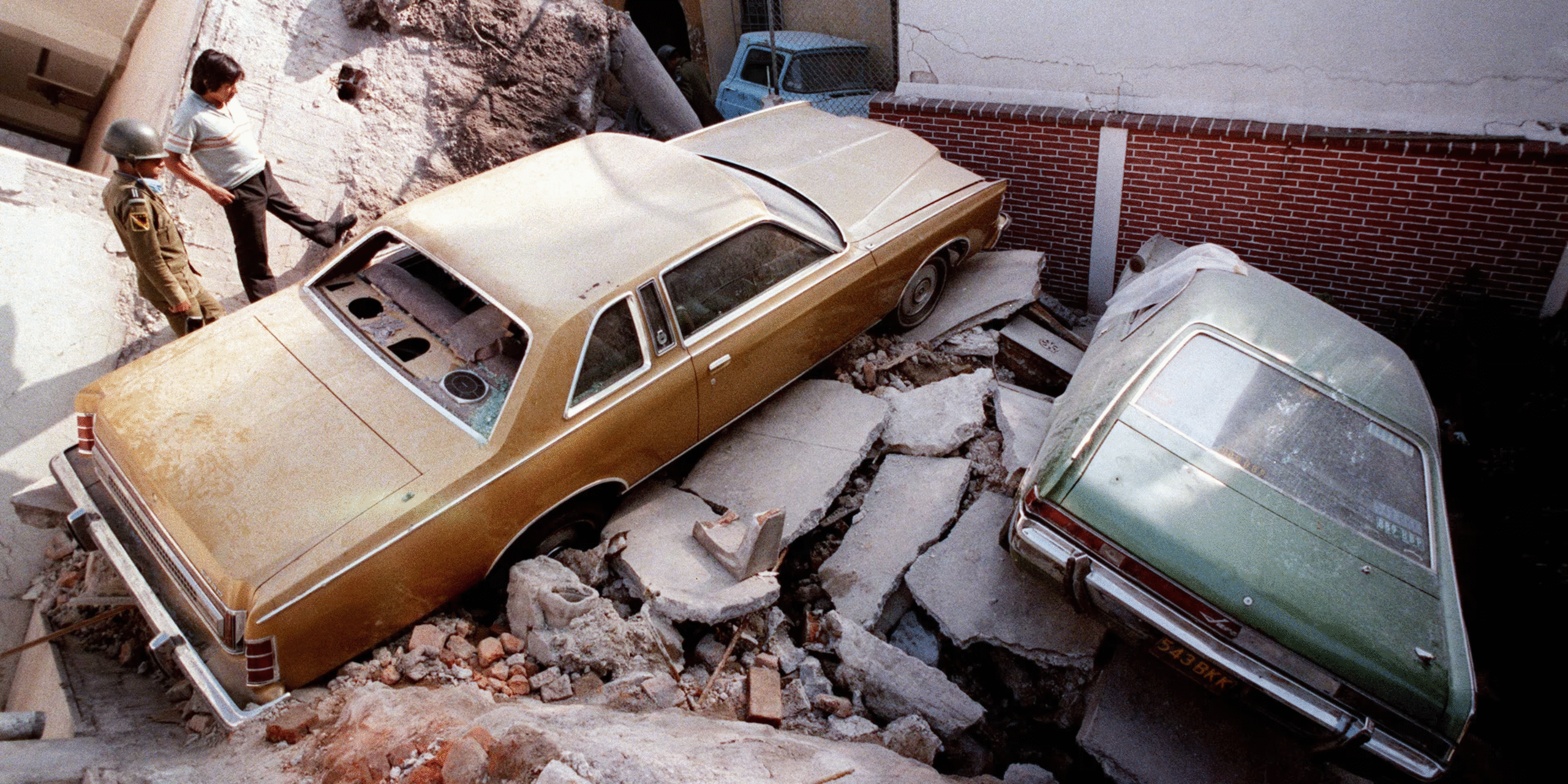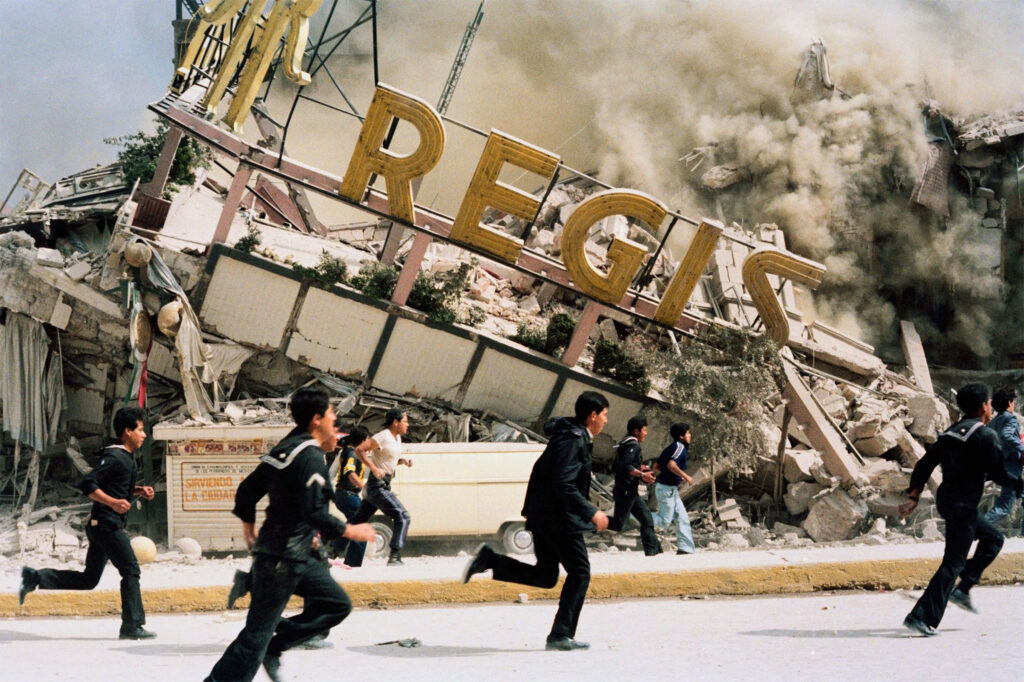This article by Daniel López Aguilar originally appeared in the September 19, 2025 edition of La Jornada, Mexico’s premier left wing daily newspaper.
At 7:19 a.m. on September 19, 1985, normalcy was shattered in an instant. The ground in Mexico City shook with a magnitude 8.1 earthquake that shattered routine: a minute and a half was enough to crumble buildings, uproot thousands of lives, and fill the air with dust, smoke, and screams.
The roar of the collapsed concrete gave way to a stunned silence, barely interrupted by sirens and cries for help. In the days that followed, firefighters and journalists documented the magnitude of the tragedy and the pain it left behind.
This impulse is what art historian Dina Comisarenco identifies as the beginning of a “cultural trauma”: a collective shock that alters identities and forces us to rework memory, reflected in symbols, stories, and expressions visible in public spaces.
 Tlatelolco 1985: Sismo y resurrección, Nicandro Puente
Tlatelolco 1985: Sismo y resurrección, Nicandro Puente
“Beyond the rubble, what remains is the testimony of a city that, amidst ruins, found a way to rise in solidarity and artistic creation,” Comisarenco explained in an interview.
This Friday marks the 40th anniversary of that dawn that marked generations. The earthquake not only collapsed buildings: it also shattered confidence in the government and awakened civil society.
“In this context, art became a space where the community could collectively process its trauma. From this emerged spaces like the Frida Kahlo gallery of the Union of Neighbors and Victims of September 19th, or the Benita Galeana gallery at the Seamstresses’ Union, where performances, assemblies, and feminist collectives gathered. Creative expression was not a luxury, but a shared language for processing devastation,” the specialist pointed out.
Few artists explicitly depicted the tragedy. The wound was too deep, and the risk of sensationalism was present. That’s why the murals that did so are so relevant.
 La historia jamás contada, Ariosto Otero
La historia jamás contada, Ariosto Otero
Works such as The Untold Story by Ariosto Otero; Homage to the Rescue by José Chávez Morado; Tlatelolco 1985: Earthquake and Resurrection by Nicandro Puente; and Tlatelolco, Place of Sacrifice (1989) by Arnold Belkin shaped the pain and fixed it in the collective memory.
“The key to its permanence lies in the fact that this collective impact needs to be inscribed in symbols that everyone can recognize. It’s a profound impact that leaves a mark on the community’s memory and transforms the way people relate to their past,” Comisarenco added.

The Birth of Visual Activism
“Through creative praxis, these experiences can be crafted into symbolic representations that allow them to be collectively processed and reinterpreted. Each painted wall was more than a surface: it was a wound made into a narrative.
 Homenaje al rescate, José Chávez Morado
Homenaje al rescate, José Chávez Morado
“The colors, figures, and scenes not only denounced what had happened; they also offered a place of recognition, a mirror in which survivors and their descendants could say: ‘We were here, we’re still here.'”
“By capturing the rescues, the faces of the victims, or the rubble transformed into geometries, the murals prevented the tragedy from being buried under custom or oblivion.”
The 1985 earthquake opened a key space for the visual arts. Painting and sculpture, although more limited in number, began to articulate testimonies of the traumatic experience, giving rise to a visual activism that combined performance, painting, and social criticism.
For Comisarenco, these expressions were essential, as they “allowed the community to collectively process its pain, to visualize the historical record, and to build identity based on the shared experience.
“Post-1985 muralism embodies the possibility of rebuilding as a community. The artistic work allows the group to redefine cultural trauma and reaffirm its identity as a community.
“Forty years after the earthquake, every chipped wall that still stands bears that lesson: memory cannot be erased; it is painted over again and again, and with it, the city continues to tell its story.”
 Tlatelolco, lugar del sacrificio Arnold Belkin
Tlatelolco, lugar del sacrificio Arnold Belkin
DEA Proposed Attacking Cartels in Mexico; White House Rejected Idea
September 19, 2025September 19, 2025
The ostensibly “anti-drug” agency called for attacks on drug trafficking leaders and military strikes on infrastructure, according to the Washington Post.
People’s Mañanera September 19
September 19, 2025
President Sheinbaum’s daily press conference, with comments on 1985 earthquake remembrance, national lottery, judicial reform, TV Azteca debts, Canada, Amparos & US accusations against Morena deputy.
September 19: A Scar That Won’t Heal
September 19, 2025
This Friday marks the 40th anniversary of that dawn that marked generations. The 1985 earthquake not only collapsed buildings: it also shattered confidence in the government and awakened civil society.
The post September 19: A Scar That Won’t Heal appeared first on Mexico Solidarity Media.
From Mexico Solidarity Media via this RSS feed





